Speech An Update on Household Finances
The extraordinary developments in global financial markets over the past couple of months have, understandably, undermined households' confidence in their finances. This has occurred around the world.
- Households have seen incredible volatility in financial prices. Daily movements in share prices of several percentage points have become the norm.
- Share prices have fallen sharply around the globe. In Australia, the share market is down about 40 per cent in 2008, resulting in negative returns in most individuals' superannuation funds.
- The difficulties in global interbank markets which had existed since August 2007 took a dramatic turn for the worse last month. The crisis, which had until then been largely confined to wholesale markets, spilled over into a severe loss of confidence among retail investors in financial institutions. Governments around the world have been forced to offer wide-ranging guarantees on banks' liabilities.
- And, to top it off, some commentators are predicting sharp falls in house prices here in Australia.
Given the daily barrage of gloom and doom, it is easy for households to lose perspective, so I thought it would be useful to take an objective look at the state of household finances. In doing so, I will focus on three key areas:
- household income;
- household balance sheets; and
- the housing market – in particular, is the Australian housing market going to go the same way as the US market?
Household Income
The first thing to say about household income is that the past five years have been an extraordinarily favourable period. Real disposable income of the household sector grew on average by 6.1 per cent per year, resulting in a cumulative increase over the five years of more than 30 per cent. One has to go back more than thirty years to find a bigger increase over a five-year period.
| Before interest | After interest | |
|---|---|---|
| 1963–1968 | 4.6 | 4.5 |
| 1968–1973 | 5.8 | 5.6 |
| 1973–1978 | 3.1 | 2.7 |
| 1978–1983 | 2.6 | 2.2 |
| 1983–1988 | 2 | 1.8 |
| 1988–1993 | 1.7 | 2.1 |
| 1993–1998 | 3.1 | 3 |
| 1998–2003 | 3.2 | 2.9 |
| 2003–2008 | 6.1 | 4.8 |
|
Deflated using the household consumption deflator; dates refer to financial years. Source: ABS |
||
Periods of strong income growth tend to be periods of strong spending and it is the job of central banks to try to keep a lid on this, to prevent excessive inflation. The past five years were therefore also a period of rising interest rates. Some commentators would have us believe that this had a crippling effect on the finances of the household sector. While some households were no doubt severely affected, the facts show that this was not the case for the sector as a whole. Even after allowing for higher interest payments, real household disposable income over the five years still increased by more than 25 per cent. This increase, too, was the largest since the early 1970s. Put another way, over the past five years, the amount of money that Australian households had left over to spend, after paying taxes and interest on all their loans, grew in real terms at the fastest rate in over 30 years.
What contributed to this surge in incomes? As usual, there were a number of factors at work:
- wage and salary income grew strongly, at about 7½ per cent per annum on average;
- income from investments grew by 17 per cent per annum on average. This was due to high dividends on shares and interest on deposits. This figure does not include the very strong capital gains on shares, which I will come to later;
- taxes payable grew less than income because we were given a series of tax cuts. This meant that disposable income grew more quickly than gross income (8.3 per cent per annum on average); and
- inflation (as measured by the consumption deflator) ate up 2.2 per cent per annum of this income growth, leaving growth in real disposable income at the figure of 6.1 per cent mentioned earlier.
This growth in household incomes in Australia greatly exceeded that in any other developed economy. In the US, for example, growth in real household disposable income was only about half that in Australia.
It is also interesting to note that the growth in income in Australia was fairly evenly distributed through the household sector. The percentage increase in real income was very similar across all the income quintiles.
In short, the boom in income in Australia was very strong by world standards and a high proportion of Australian households shared it.
These facts help us to understand how we got to where we are, but the more relevant question for households is: where are we heading over the coming five years?
I think it is now widely accepted that growth in real incomes over the next year or two will be more subdued than over the past five years. How subdued will depend importantly on the effects of the financial turmoil. Nobody knows how significant they will turn out to be but it would be reasonable to assume that income growth for the household sector will be noticeably below average over the next year or two.
Beyond the next couple of years, the future is harder to predict, but there is no reason at this stage to doubt that past patterns will be repeated and that growth will pick up again. Australia remains, after all, a very dynamic economy.
The outcomes in Australia will, as usual, be influenced to some degree by global developments. At present, the major developed economies seem to be moving into recession, as they tend to do every seven to ten years. The last such recession was in 2001, so the one that is emerging at present seems to be pretty much on cue.
The Bank has been factoring weaker global economic growth into its policy assessment for much of this year. Throughout this period, we have been forecasting lower growth than the major international forecasters. Even so, the events of the past couple of months have caused us to revise our forecasts down further.
Australia managed to sidestep the 2001 global recession. Can it do that again?
That is certainly what we are aiming for, and there is nothing in the data to date to suggest that we are off track. But the economy is being affected by powerful forces from different directions, and it is unclear what the net effect will be. The impact of global developments is particularly uncertain.
We also have to recognise that the task of managing the economy this time will be more difficult than in 2001 because we are starting with a bigger inflation overhang. The Bank has for some time thought that inflation would peak in the second half of 2008 and then fall; accordingly, we have acted pre-emptively in reducing interest rates. Nonetheless, there is still a big task ahead to bring inflation down and this could limit room for manoeuvre on monetary policy.
Many people will be disappointed and unhappy with a year or two of below-average economic performance. But the truth is that the economy cannot always grow above average and it certainly cannot maintain the pace of the past five years. If we attempted to make it do so, we would be repeating the mistakes of our predecessors in the 1960s, whose attempts to maintain a never-ending boom laid the foundations for the subsequent two decades of severe economic difficulties.
One of the factors that helped keep Australia from following the developed economies into recession in 2001 was our increasing links to Asia, and China in particular. These links have strengthened further since 2001, with China now Australia's largest trading partner.
It would be naïve to assume that China will not experience an economic cycle, so we should expect its demand for our resources to fluctuate. However, China's strong long-term growth potential must be a source of optimism about our own long-term prosperity, given our role as one of its most important suppliers of raw materials.
Household Balance Sheets
I would like to turn now to household balance sheets.
Australian households have much bigger holdings of financial assets than financial liabilities. Financial assets at 30 June averaged around $275,000 per household while liabilities averaged $150,000 per household. Since then, we estimate that average assets have fallen to around $245,000 per household, though this is still quite a strong position.
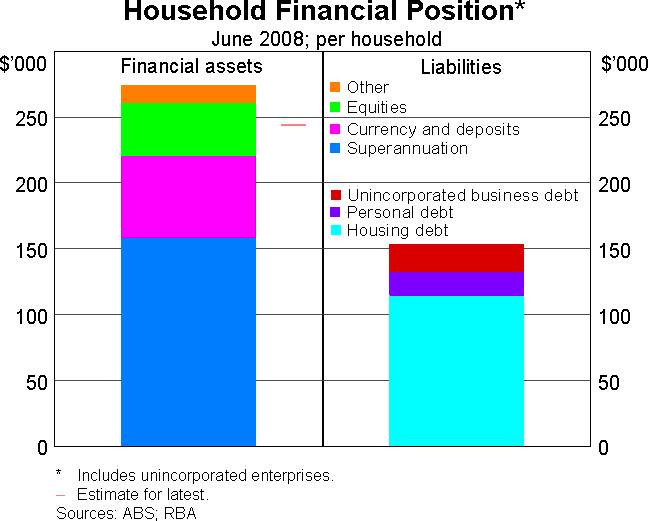
The composition of assets and liabilities is very different.
- The liabilities consist mainly of borrowings from banks and other lenders where the value is fixed and on which regular interest has to be paid.
- Household financial assets, however, consist mainly of market-linked investments.
This balance sheet structure is very favourable in terms of maximising long-run accumulation of wealth, because the return on these assets over long terms exceeds the cost of debt by a substantial margin. The returns do not, however, accumulate evenly from year to year. Some years produce very strong returns while others produce negative returns.
We are currently going through one of those periods of negative returns. As I mentioned, the Australian share market has fallen sharply this year. Largely because of this, the typical balanced superannuation fund experienced a negative return of about 8 per cent last financial year. Returns are again negative so far this financial year.
Naturally, people find this very distressing. But it is not the first time this has happened. Over the past 100 years, the share market on average has had negative returns every 5 years.
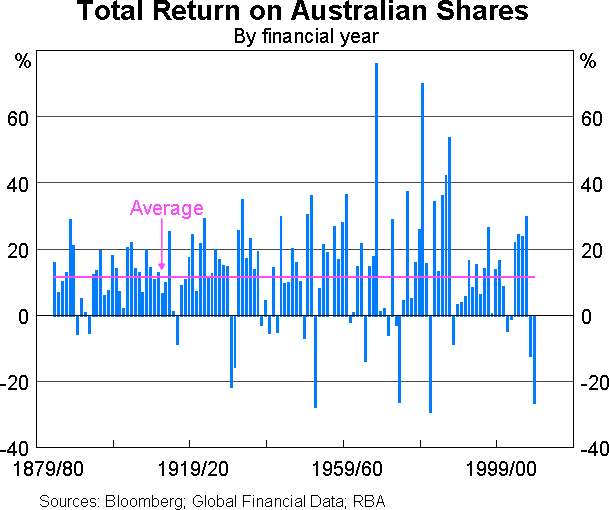
While the sharp fall in share prices since late last year is confronting, the thing that needs to be kept in mind is that it was preceded by four years of extremely strong returns. As such, even after this year's fall, anybody who has held shares over the past five years would still have earned 8 per cent a year on average. That is still more than the return on government bonds or bank deposits over the period.
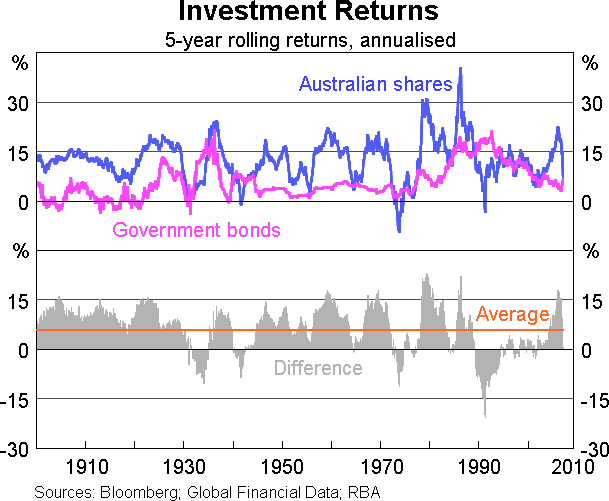
The uneven pattern in share market returns partly reflects the economic cycle and partly reflects the influence of human behaviour. As investors, we find it difficult to distinguish the cycle from the trend. In particular, after a few years, a cyclical upswing starts to look like a trend and more of us try to jump aboard. Eventually this pushes asset prices to levels that are higher than can be justified by the income produced by the asset, and prices correct down.
Investments in shares tend to compensate the holder for the short-run volatility in returns by producing higher returns over the long run. If they did not, nobody would invest in them. These higher returns can compound to very large amounts over time.
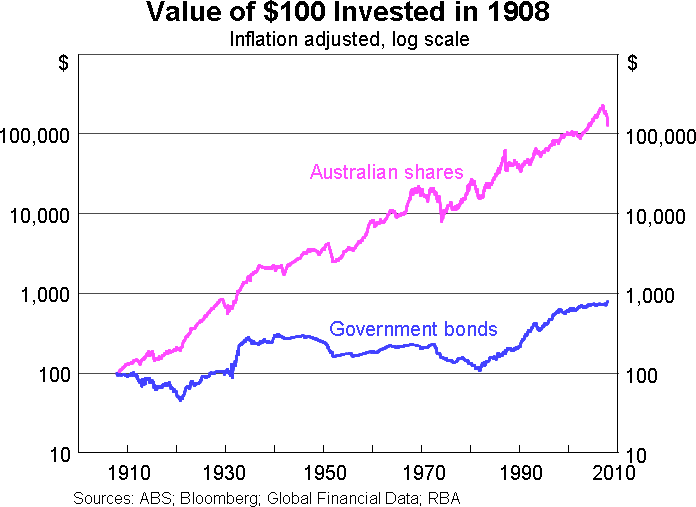
As an illustration of this, assume somebody had $100 (in today's money) to invest 100 years ago:
- If they put this in government bonds, and assuming all the interest was re-invested in bonds along the way, the investment would today be worth about $800. This is an annual real return of 2 per cent.
- If they put it in the Australian share market, and again assuming that all dividends were re-invested in shares, it would today be worth about $130,000. This is an annual real return of 7 per cent.
The difference between these two rates of return – 5 percentage points per year – is the risk premium that investors have received for investing in the share market.
At present, the risk premium is higher than this because investors have become very nervous. The increase in the risk premium demanded by investors has been an important factor causing share prices to fall in recent months. The one-year forward earnings yield on Australian shares has risen to 11 per cent, well above the long-run average. This is a very attractive yield. When the yield has risen to these levels in the past, the return on shares over the subsequent 10 years has almost always been well above average.
The Housing Market
Finally, I would like to make a few comments about the housing market.
Some commentators who have looked at the US housing market feel they have seen the future for the Australian market. In some ways, this is understandable because economic developments in Australia have in the past often mirrored those in the US.
As you know, the ratio of housing costs to income has been unusually high in recent years and it is not unreasonable to expect that it will decline over time. But this ratio can adjust in several ways: lower house prices, rising incomes or falling interest rates. In the US, falls in house prices have been a big part of the adjustment. I think there are reasons, however, to believe that the Australian housing market will not follow the US market to the same degree. Let me run through some of these reasons.
First, the cycle in the Australian housing market, rather than following the US market, is in fact at a more advanced stage; it is probably leading the US market by three years or so. The Australian housing market was at its hottest in 2003, whereas the US market peaked in 2006.
To understand how this came about, it is necessary to look back to the second half of the 1990s. The tremendous shift in the global savings/investment balance that followed the Asian crisis generated a surplus of funds in global markets. The financial sectors in the English-speaking countries, being more dynamic and responsive than in many other countries, were quick to take advantage of this. In the US, the early part of this period coincided with a surge in technological innovation, and the initial wave of money in that country went to the technology sector. This resulted in the ‘tech’ bubble, which eventually collapsed in 2000.
Australia did not have much of a technology-producing sector so our financial institutions sought out other investment opportunities. What Australia did have was a conservative household sector with relatively low gearing. As such, the financial sector saw opportunities for financial innovation aimed at encouraging households to make greater use of their borrowing capacity. Most of this was focused on housing lending.
The result was that the boom in housing in Australia got underway well before that in the US the latter did not really get going until after the tech bubble collapsed.
A second difference relates to the dynamics of the housing markets in the two countries. In the US, the rise in house prices elicited a very strong supply response so that, by the end of 2007, there was almost one-year's supply of newly built unsold houses overhanging the market. US house prices stopped rising essentially because the supply of houses overtook demand.

Here in Australia the rise in house prices did not elicit such a strong supply response. There were pockets of overdevelopment in apartments in 2003/04 but, by and large, there was never a serious oversupply of unsold new houses in Australia. In fact, the consensus is that there is currently a shortage of dwellings.
The Australian housing boom ended because prices rose to levels that severely strained the financial capacity of buyers to pay higher prices, not because too many houses were built, as in the US.
The overhang of unsold houses in the US has created downward pressure on house prices as builders and developers have been forced to sell. This is absent in Australia. Rather, the shortage of housing here means that there are buyers waiting for better circumstances – e.g. lower interest rates or rising incomes – to facilitate their entry to the market. This latent underlying demand for housing is a factor that will support the market.
A third important difference between Australia and the US is in the groups that the lenders targeted, and in the loan terms on offer. In Australia, the lending boom was concentrated on existing home owners who traded up to bigger and better houses and bought investment properties. Many of these were people in their 40s and 50s who previously had low levels of debt. At the end of the boom, the home ownership rate in Australia was no different to that at the start; in both cases about 70 per cent.
While one could argue that no socially productive purpose was served by this increased lending to middle-aged existing home owners, it did mean that the loans largely went to those who had a strong capacity to service and repay them. As a result, whereas most other countries with housing booms have experienced a strong rise in arrears on housing loans once the boom ended, in Australia the arrears rate is today no higher than it was at the start of the boom in the mid 1990s. And, of course, it is low by international standards.
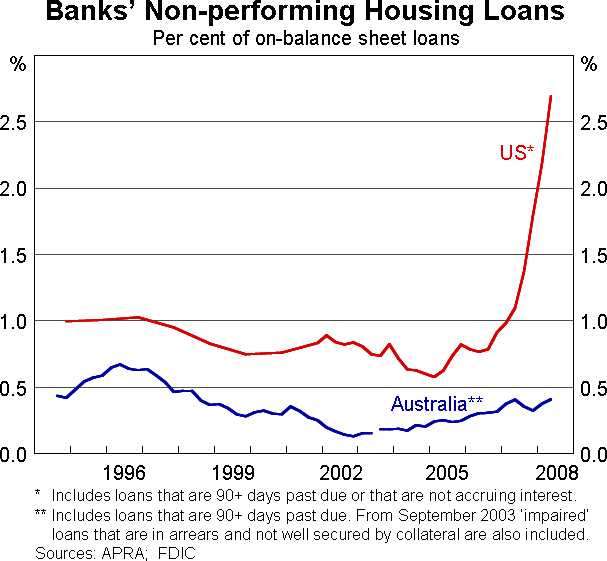
In the US, in contrast, a lot of the lending found its way to more marginal borrowers who previously could not afford a loan, or it took the form of aggressively structured mortgages which allowed people to borrow much more than they previously could. The home ownership rate in the US continued to rise during the first years of the boom. One could argue that this was a good thing, but one consequence was that a significant proportion of this group ended up having trouble servicing their loans; hence, the sharp rise we have seen in US loan delinquencies.
In setting out these differences, I don't want to leave the impression that the Australian housing market is without its problems. There is no denying that there is a significant number of people who are facing difficulties with housing loan repayments, especially in western Sydney where arrears rates are significantly higher than in other parts of Australia.
While lending standards in Australia did not deteriorate to anywhere near the same extent as in the US, loans sourced from new, non-traditional lenders have ended up with higher rates of arrears than those of traditional lenders. The arrears, even on prime, full-doc loans made by this new group of lenders are three times higher than those on similar loans sourced from the major banks. In addition, a higher proportion of loans granted by these lenders were low-doc or non-conforming, the arrears rates on which are significantly higher than those on prime loans. One can only conclude that these lenders had lower credit standards than traditional lenders, and while this may have benefited some borrowers, it has ended up causing significant hardship for others.
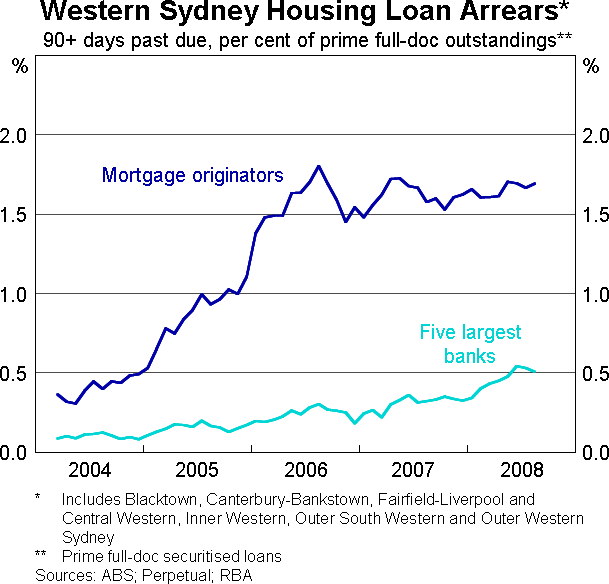
One of the issues that has been highlighted by events in the US is the importance of having adequate regulation of lending and loan brokers. In Australia, all lenders were covered by the Uniform Consumer Credit Code but loan brokers were much more lightly regulated, until very recently. The Council of Australian Governments earlier this year recognised that regulation needed to be strengthened and agreed to transfer responsibility for the regulation of all consumer credit to the Commonwealth. This is due to take effect by the middle of next year and should ensure that regulation of this very important financial activity is put on an even sounder footing.
Conclusion
We are going through some uncertain financial times at present, which is leading some to question whether the period of prosperity that has been running for almost two decades has come to an end.
While nobody can predict accurately all that lies ahead, it is important not to become too pessimistic because, fundamentally, household finances and the economy more generally remain in good shape. The main problem that had built up – inflation – is manageable and is being dealt with.
The next couple of years will be noticeably more subdued than the past five. We should not be surprised by this as the income and wealth generated over the past five years were simply extraordinary.
By definition, the economy must grow at a below-average pace for some of the time. These periods provide the economy with the breathing space to sustain the expansion. There is no reason to assume that the next year or two will not do the same.
